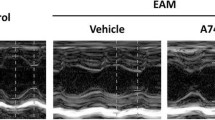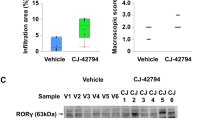Abstract
Purpose
Myocarditis is an acute inflammatory disease of the heart and is often a precursor of dilated cardiomyopathy. Experimental autoimmune myocarditis (EAM) has been used as a model for human myocarditis. The purpose of this study was to investigate the therapeutic role of 3-hydroxy-3-methyl-glutaryl coenzyme A (HMG-CoA) reductase inhibitor, rosuvastatin, on the development of EAM.
Methods
Experimental autoimmune myocarditis was induced in BALB/c mice by immunization with murine cardiac α-myosin heavy chain (MyHc-α614–629 [Ac-SLKLMATLFSTYASAD-OH]). High-dose (10 mg/kg/day) or low-dose (1 mg/kg/day) rosuvastatin or vehicle was administered orally by gastric gavage to mice with EAM from day 0 to day 21 after immunization. On day 21 after immunization, echocardiography was carried out and the severity of myocarditis was detected by histopathological evaluation. Levels of serum tumor necrosis factor (TNF)-α and interleukin (IL)-6 were measured by ELISA. Histopathology was performed using haematoxylin and eosin. With apoptosis examined by Tunel, the expression of active caspase-3 in myocardium was investigated by immunohistochemistry.
Results
Rosuvastatin attenuated the histopathological severity of myocarditis. Cardiac function was improved in the two rosuvastatin-treated groups compared to the non-treated EAM group (LVFS: high-dose rosuvastatin group [group H], 0.38 ± 0.10%; low-dose rosuvastatin group [group L], 0.34 ± 0.06%; non-treated EAM group [group N], 0.29 ± 0.07%. LVEF: group H, 0.80 ± 0.09%; group L, 0.71 ± 0.07%; group N, 0.68 ± 0.07%). Furthermore, treatment with rosuvastatin decreased the expression levels of TNF-α (group H, 65.19 ± 7.06 pg/ml; group L, 108.20 ± 5.28 pg/ml; group N, 239.34 ± 11.65 pg/ml) and IL-6 (group H, 14.33 ± 2.15 pg/ml; group L, 19.67 ± 3.04 pg/ml; group N, 40.39 ± 7.17 pg/ml). The rates of expression of active Caspase-3 and myocardial apoptosis were positively correlated with the scores for myocardial pathology.
Conclusions
These results demonstrate that administration of rosuvastatin can ameliorate EAM progression, inhibit apoptosis of cardiomyocytes, and preserve cardiac output, and they also suggest rosuvastatin may be a promising novel therapeutic strategy for the clinical treatment of myocarditis.






Similar content being viewed by others
References
Kallwellis-Opara A, Dorner A, Poller WC, Noutsias M, Kuhl U, Schultheiss HP, et al. Autoimmunological features in inflammatory cardiomyopathy. Clin Res Cardiol. 2007;96:469–80.
Kuhl U, Pauschinger M, Bock T, Klingel K, Schwimmbeck CP, Seeberg B, et al. Parvovirus B19 infection mimicking acute myocardial infarction. Circulation. 2003;108:945–50.
Cai G, Zhang J, Liu L, Shen Q. Successful treatment of experimental autoimmune myocarditis by adenovirus-mediated gene transfer of antisense CIITA. J Mol Cell Cardiol. 2005;38:593–605.
Neu N, Beisel KW, Traystman MD, Rose NR, Craig SW. Autoantibodies specific for the cardiac myosin isoform are found in mice susceptible to Coxsackievirus B3-induced myocarditis. J Immunol. 1987;138:2488–92.
Youssef S, Stuve O, Patarroyo JC, Ruiz PJ, Radosevich JL, Hur EM, et al. The HMG-CoA reductase inhibitor, atorvastatin, promotes a Th2 bias and reverses paralysis in central nervous system autoimmune disease. Nature. 2002;420:78–84.
Azuma RW, Suzuki J, Ogawa M, Futamatsu H, Koga N, Onai Y, et al. HMG-CoA reductase inhibitor attenuates experimental autoimmune myocarditis through inhibition of T cell activation. Cardiovasc Res. 2004;64:412–20.
Zhou Q, Liao JK. Statins and cardiovascular diseases: from cholesterol lowering to pleiotropy. Curr Pharm Des. 2009;15:467–78.
Cruz-Adalia A, Jimenez-Borreguero LJ, Ramirez-Huesca M, Chico-Calero I, Barreiro O, Lopez-Conesa E, et al. CD69 limits the severity of cardiomyopathy after autoimmune myocarditis. Circulation. 2010;122:1396–404.
Whaley-Connell A, Habibi J, Nistala R, Cooper SA, Karuparthi PR, Hayden MR, et al. Attenuation of NADPH oxidase activation and glomerular filtration barrier remodeling with statin treatment. Hypertension. 2008;51:474–80.
Calkin AC, Giunti S, Sheehy KJ, Chew C, Boolell V, Rajaram YS, et al. The HMG-CoA reductase inhibitor rosuvastatin and the angiotensin receptor antagonist candesartan attenuate atherosclerosis in an apolipoprotein E-deficient mouse model of diabetes via effects on advanced glycation, oxidative stress and inflammation. Diabetologia. 2008;51:1731–40.
Pan HY, Yamada H, Chida J, Wang S, Yano M, Yao M, et al. Up-regulation of ectopic trypsins in the myocardium by influenza A virus infection triggers acute myocarditis. Cardiovasc Res. 2011;89:595–603.
Goser S, Ottl R, Brodner A, Dengler TJ, Torzewski J, Egashira K, et al. Critical role for monocyte chemoattractant protein-1 and macrophage inflammatory protein-1alpha in induction of experimental autoimmune myocarditis and effective anti-monocyte chemoattractant protein-1 gene therapy. Circulation. 2005;112:3400–7.
Li WM, Liu W, Gao C, Zhou BG. Immunoregulatory effects of atorvastatin on experimental autoimmune myocarditis in Lewis rats. Immunol Cell Biol. 2006;84:274–80.
Yano M, Matsumura T, Senokuchi T, Ishii N, Murata Y, Taketa K, et al. Statins activate peroxisome proliferator-activated receptor gamma through extracellular signal-regulated kinase 1/2 and p38 mitogen-activated protein kinase-dependent cyclooxygenase-2 expression in macrophages. Circ Res. 2007;100:1442–51.
Cicha I, Schneiderhan-Marra N, Yilmaz A, Garlichs CD, Goppelt-Struebe M. Monitoring the cellular effects of HMG-CoA reductase inhibitors in vitro and ex vivo. Arterioscler Thromb Vasc Biol. 2004;24:2046–50.
Takemoto M, Sun J, Hiroki J, Shimokawa H, Liao JK. Rho-kinase mediates hypoxia-induced downregulation of endothelial nitric oxide synthase. Circulation. 2002;106:57–62.
Ni W, Egashira K, Kataoka C, Kitamoto S, Koyanagi M, Inoue S, et al. Antiinflammatory and antiarteriosclerotic actions of HMG-CoA reductase inhibitors in a rat model of chronic inhibition of nitric oxide synthesis. Circ Res. 2001;89:415–21.
Li Y, Heuser JS, Kosanke SD, Hemric M, Cunningham MW. Cryptic epitope identified in rat and human cardiac myosin S2 region induces myocarditis in the Lewis rat. J Immunol. 2004;172:3225–34.
Salek-Ardakani S, Croft M. Tumor necrosis factor receptor/tumor necrosis factor family members in antiviral CD8 T-cell immunity. J Interferon Cytokine Res. 2010;30:205–18.
Tang Z, McGowan BS, Huber SA, McTiernan CF, Addya S, Surrey S, et al. Gene expression profiling during the transition to failure in TNF-alpha over-expressing mice demonstrates the development of autoimmune myocarditis. J Mol Cell Cardiol. 2004;36:515–30.
Sivasubramanian N, Coker M, Kurrelmeyer K, MacLellan W, DeMayo F, Spinale F, et al. Left ventricular remodeling in transgenic mice with cardiac restricted overex-pression of tumor necrosis factor. Circulation. 2001;104:826–31.
Hedayat M, Mahmoudi MJ, Rose NR, Rezaei N. Proinflammatory cytokines in heart failure: double-edged swords. Heart Fail Rev. 2010;15:543–62.
Wu JL, Matsui S, Zong ZP, Nishikawa K, Sun BG, Katsuda S, et al. Amelioration of myocarditis by statin through inhibiting cross-talk between antigen presenting cells and lymphocytes in rats. J Mol Cell Cardiol. 2008;44:1023–31.
Yamauchi-Takihara K, Kishimoto T. Cytokines and their receptors in cardiovascular diseases–role of gp130 signalling pathway in cardiac myocyte growth and maintenance. Int J Exp Pathol. 2000;81:1–16.
Yu X, Kennedy R, Liu S. JAK2/STAT3, not ERK1/2, mediates interleukin-6-induced activation of inducible nitricoxide synthase and decrease in contractility of adult ventricular myocytes. J Biol Chem. 2003;278:16304–9.
Siwik D, Chang D, Colucci W. Interleukin-1beta and tumor necrosis factor-alpha decrease collagen synthesis and increase matrix metalloproteinase activity in cardiac fibroblasts in vitro. Circ Res. 2000;86:1259–65.
Atreya R, Mudter J, Finotto S, Mullberg J, Jostock T, Wirtz S, et al. Blockade of interleukin 6 trans signaling suppresses T-cell resistance against apoptosis in chronic intestinal inflammation: evidence in crohn disease and experimental colitis in vivo. Nat Med. 2000;6:583–8.
Eriksson U, Kurrer MO, Schmitz N, Marsch SC, Fontana A, Eugster HP, et al. Interleukin-6-deficient mice resist development of autoimmune myocarditis associated with impaired upregulation of complement C3. Circulation. 2003;107:320–5.
Node K, Fujita M, Kitakaze M, Hori M, Liao JK. Short-term statin therapy improves cardiac function and symptoms in patients with idiopathic dilated cardiomyopathy. Circulation. 2003;108:839–43.
Green D, Reed J. Mitochondria and apoptosis. Science. 1998;281:1309–12.
Haudek S, Taffet G, Schneider M, Mann D. TNF provokes cardiomyocyte apoptosis and cardiac remodeling through activation of multiple cell death pathways. J Clin Invest. 2007;117:2692–791.
Enari M, Sakahira H, Yokoyama H, Okawa K, Iwamatsu A, Nagata S. A caspase-activated DNase that degrades DNA during apoptosis, and its inhibitor ICAD. Nature. 1998;391:43–50.
Ito M, Adachi T, Pimentel DR, Ido Y, Colucci WS. Statins inhibit beta-adrenergic receptor-stimulated apoptosis in adult rat ventricular myocytes via a Rac1-dependent mechanism. Circulation. 2004;110:412–8.
Abraham SS, Osorio JC, Homma S, Wang J, Thaker HM, Liao JK, et al. Simvastatin preserves cardiac function in genetically determined cardiomyopathy. J Cardiovasc Pharmacol. 2004;43:454–61.
Bergmann MW, Rechner C, Freund C, Baurand A, El Jamali A, Dietz R. Statins inhibit reoxygenation-induced cardiomyocyte apoptosis: role for glycogen synthase kinase 3beta and transcription factor beta-catenin. J Mol Cell Cardiol. 2004;37:681–90.
Sharma H, Pathan RA, Kumar V, Javed S, Bhandari U. Anti-apoptotic potential of rosuvastatin pretreatment in murine model of cardiomyopathy. Int J Cardiol. 2011;150:193–200.
Acknowledgements
This work was supported by the National 973 Basic Research Program of China (No.2009CB521904) and the grant of Natural Science Foundation of Shandong Province (Y2007C074). We greatly appreciate Doctor Shanying Huang and Hong Jiang for their excellent technical assistances.
Author information
Authors and Affiliations
Corresponding authors
Additional information
Xiaoman Liu and Bo Li contributed equally to this paper.
Rights and permissions
About this article
Cite this article
Liu, X., Li, B., Wang, W. et al. Effects of HMG-CoA Reductase Inhibitor on Experimental Autoimmune Myocarditis. Cardiovasc Drugs Ther 26, 121–130 (2012). https://doi.org/10.1007/s10557-012-6372-6
Published:
Issue Date:
DOI: https://doi.org/10.1007/s10557-012-6372-6




